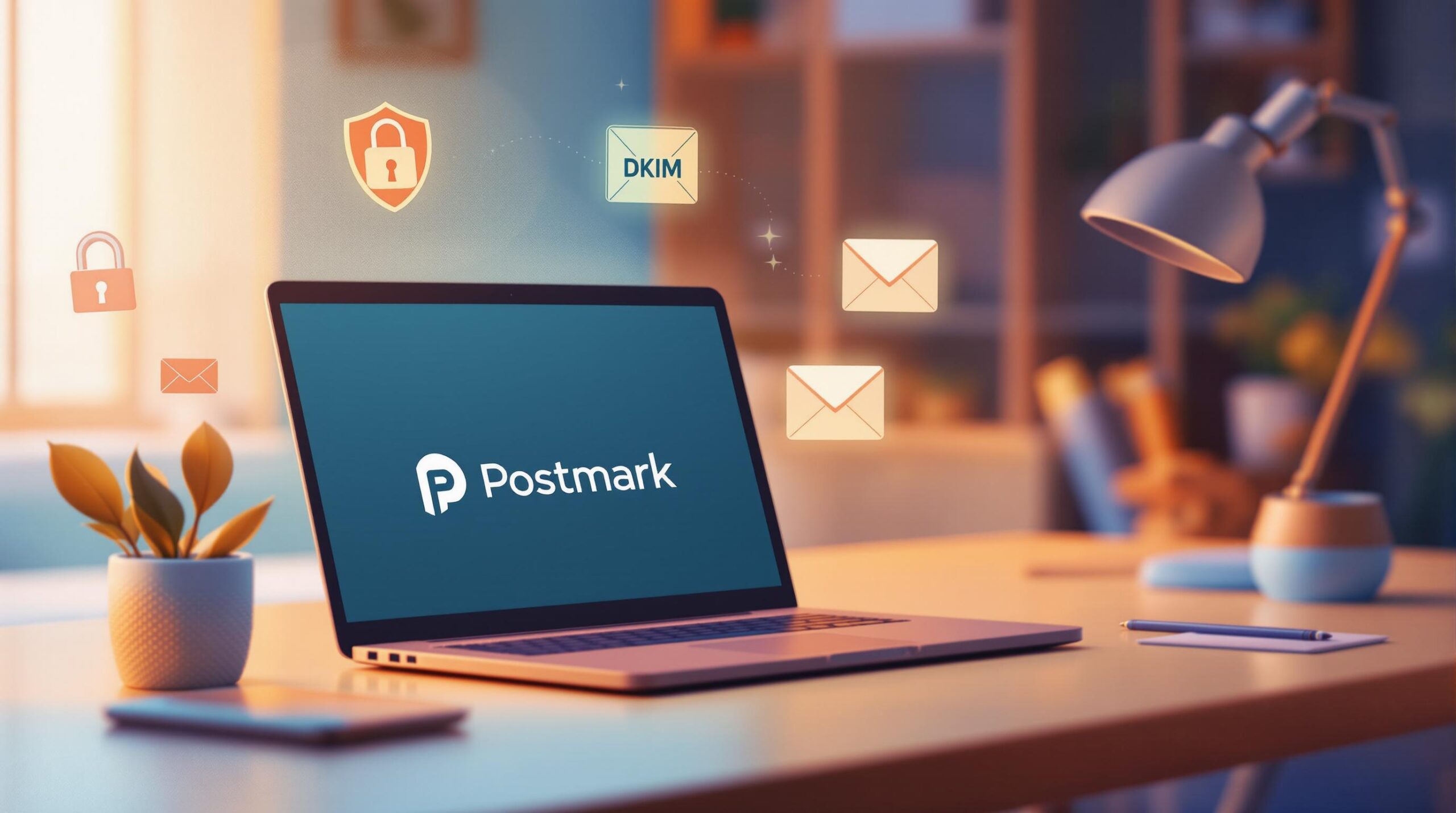DKIM (DomainKeys Identified Mail) ensures your emails are secure and trusted by adding a digital signature to them. Starting February 2024, email providers like Google and Yahoo require DKIM for bulk senders to ensure better deliverability and prevent domain spoofing. Here’s how to set it up with Postmark:
-
What You Need:
- An active Postmark account with sending privileges.
- Admin access and DNS management rights.
- Verified domain ownership.
-
Steps to Set Up:
- Log in to Postmark and generate DKIM keys in the "Sender Signatures" section.
- Add the provided DKIM TXT record to your DNS settings.
- Verify the setup using Postmark’s tools or DNS commands.
-
Additional Tips:
- Combine DKIM with SPF and DMARC for stronger email authentication.
- Use tools like Bouncebuster to maintain clean email lists.
This setup protects your domain, improves email delivery, and ensures compliance with stricter email authentication requirements.
Authenticate Your Email Domain With Postmark
Before You Start
Make sure you have the necessary accounts and permissions ready before setting up DKIM in Postmark.
Accounts and Permissions You’ll Need
To configure DKIM, you’ll require the following:
- An Active Postmark Account: Your account must be verified and have sending privileges.
- Verified Domain Ownership: Proof that you control the domain you’ll use for sending emails.
- Admin Access: The right administrative permissions within your Postmark account.
Additionally, ensure you have access to manage your DNS settings to add the required DKIM records.
Access to DNS Management
Log in to your DNS control panel to confirm you can view, modify, or add TXT records. Popular DNS providers include cPanel, Cloudflare, GoDaddy, Namecheap, and Amazon Route 53.
Here are some key points to check:
-
Where to Manage DNS
Access your domain registrar or hosting provider’s control panel and locate the DNS management section (often labeled as DNS Manager or Advanced DNS Settings). -
DNS Propagation Time
Keep in mind that DNS updates may take up to 72 hours to fully propagate. If you don’t have access, reach out to your domain administrator for assistance.
sbb-itb-f42cab2
Setting Up DKIM in Postmark
Creating DKIM Keys
To set up DKIM in Postmark, you’ll first need to generate DKIM keys. Postmark uses 1024-bit DKIM keys for this process .
Here’s how to generate your keys:
- Log into your Postmark account.
- Navigate to the "Sender Signatures" section.
- Find your domain in the list.
- Click "DNS Settings" or "Add a DKIM DNS record".
Adding the DKIM Record to Your DNS
Once you’ve generated the DKIM keys, you’ll need to update your domain’s DNS settings by adding the DKIM record provided by Postmark. This involves creating a new TXT record using the details supplied.
Steps to add the DKIM record:
- Log in to your DNS provider’s control panel.
- Add a new TXT record.
- Copy the exact Hostname provided by Postmark.
- Paste the Value exactly as shown in Postmark.
- Save your changes.
Keep in mind that DNS updates can take 24–48 hours to propagate across the internet. During this period, your DKIM status in the Postmark dashboard might still show as pending.
Verifying Your DKIM Setup
After adding the DKIM record, you’ll need to confirm that it’s working properly. Here’s how to test it:
- Use Postmark’s built-in verification tool by clicking "Verify" in the dashboard.
- Check DNS propagation by running the following command:
$ dig YOUR-SELECTOR._domainkey.YOUR-DOMAIN.com txt - Send a test email and inspect the email headers. Here’s how to view headers in common email clients:
- Gmail: Click the three-dot menu (⁝) and select "Show original".
- Mac Mail: Go to View → Message → Raw Source.
- Outlook: Right-click the email and choose "View Source".
Look for the DKIM-Signature and Authentication-Results headers to confirm everything is set up correctly .
"Postmark makes it super easy to verify domain ownership using DKIM." – Postmark Team
Once verified, Postmark will automatically sign all emails sent through your domain with DKIM. This ensures that any email address under your verified domain is authenticated without requiring further configuration.
Improving Email Delivery
Once you’ve set up DKIM in Postmark, you can further improve email deliverability by adding more layers of authentication and using verification tools.
Adding SPF and DMARC
SPF and DMARC work alongside DKIM to enhance email security and improve delivery rates. DMARC, in particular, helps recipients determine how to handle emails that fail authentication checks. This combined setup strengthens your domain’s protection and ensures smoother email delivery .
Here are some key benefits of DMARC:
- Protection and Reputation: DMARC helps prevent fraud, as seen in a 2013 PayPal campaign where it significantly reduced phishing attempts .
- Better Visibility: DMARC reports show who is sending emails from your domain, making it easier to spot and fix authentication issues .
To implement DMARC effectively:
-
Start with a monitoring policy
Begin with a policy set top=none. This allows you to collect data on your email flows without affecting delivery. -
Review and refine
Analyze DMARC reports to ensure legitimate emails are authenticated correctly. Research from Valimail highlights that 75–80% of domains with DMARC records face challenges with enforcement due to configuration errors . -
Gradually enforce stricter policies
Once you’re confident legitimate emails are passing authentication:- Start with
p=quarantinefor a small percentage of failures. - Slowly increase the percentage as issues are resolved.
- Finally, move to
p=rejectfor full enforcement.
- Start with
Using real-time verification tools alongside these protocols can further boost your sender reputation.
Using Bouncebuster for Verification
After setting up authentication, it’s important to verify recipient lists to avoid delivery problems. Bouncebuster is a tool that integrates seamlessly with Postmark to ensure your emails reach valid addresses .
Here are some best practices for email verification:
- Pre-send Verification: Check email addresses before adding them to your list to minimize hard bounces.
- Regular List Maintenance: Periodically clean your email lists to remove invalid addresses.
- API Integration: Use Bouncebuster’s REST API for real-time verification when collecting email addresses.
| Metric | Warning Threshold | Recommended Action |
|---|---|---|
| Open Rate | Below 30% | Check your authentication setup and list quality. |
| Spam Rate | Above 10% | Pause campaigns and implement a warm-up process. |
| Email Size | Over 100KB | Optimize the content to reduce size. |
Summary
DKIM Setup Results
Setting up DKIM through Postmark adds an extra layer of security to your emails. Once configured and verified, your domain’s emails include digital signatures that:
- Prove the email’s origin to receiving servers.
- Ensure messages remain unchanged during transit.
- Boost deliverability by building trust with email providers.
- Lower the chances of being flagged as spam.
These benefits highlight why regular upkeep is crucial for reliable email authentication.
Maintaining Email Authentication
| Maintenance Task | Frequency | Purpose |
|---|---|---|
| DKIM Key Rotation | Every 3 months | Keep security measures up-to-date |
| DMARC Report Review | Weekly | Track authentication performance |
| DNS Record Verification | Monthly | Ensure records remain accurate |
To maintain strong email authentication, consider these steps:
- Use DMARC monitoring services to analyze authentication reports.
- Check DKIM-Signature headers in your sent emails regularly.
- Validate DNS records with tools like DKIM Core Key Check .
- Keep your SPF and DMARC policies aligned with DKIM.
When rotating keys, Postmark ensures smooth transitions by keeping the old private key active until the new public key is fully propagated . This avoids any interruptions in email delivery during the update process.



